The South Carolina Department of Natural Resources will map and remove derelict crab traps found in South Carolina coastal estuaries, and use the collected traps to build oyster reef habitats to reduce erosion and habitat loss.
Type of Project: Removal
Region: Southeast
Project Dates: September 2021 - August 2024
Who is involved?
With support from NOAA Marine Debris Program, the South Carolina Department of Natural Resources is partnering with different divisions within the agency to assist with derelict crab trap detection, mapping, and removal. Additionally, the agency will collaborate with the Bears Bluff National Fish Hatchery and volunteers to construct and monitor derelict trap oyster reefs.
What is the project and why is it important?
The blue crab fishery is one of the largest commercial fisheries in South Carolina, bringing in approximately $5 million per year since 2012. Millions of pounds of blue crabs are caught annually by both commercial and recreational crabbers, many using a wire crab trap attached to a rope and floating buoy. However, these traps are sometimes abandoned or become lost when displaced in storms or high tides or when their lines are separated by boat propellers or wear and tear. These derelict crab traps can then become navigational hazards, damage important habitats, and ghost fish by continuing to catch and kill target and non-target species well after the trap is lost.
To address this marine debris issue, the South Carolina Department of Natural Resources will focus on removing derelict crab traps in intertidal and subtidal areas of South Carolina coastal estuaries. Their team will work to locate and map derelict traps through visual assessments, an uncrewed aerial vehicle (UAV), and side-imaging sonar. The project plans to remove a subset of traps identified through their mapping efforts - about 130 derelict crab traps, weighing an estimated 1,620 pounds. The number and type of bycatch species found in the traps will be documented and released, if alive. Recovered traps will be used as a base to build oyster reef habitats that help reduce erosion and habitat loss. In addition to the surveys and mapping of four estuaries, the project is updating a state-wide web-based tool to report derelict traps and increase public awareness.
For more information about this project, visit the Marine Debris Program Clearinghouse.
 An official website of the United States government.
An official website of the United States government. 
